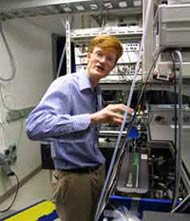
Handy Links
SLAC News Center
SLAC Today
- Subscribe
- Archives: Feb 2006-May 20, 2011
- Archives: May 23, 2011 and later
- Submit Feedback or Story Ideas
- About SLAC Today
SLAC News
Lab News
- Interactions
- Lightsources.org
- ILC NewsLine
- Int'l Science Grid This Week
- Fermilab Today
- Berkeley Lab News
- @brookhaven TODAY
- DOE Pulse
- CERN Courier
- DESY inForm
- US / LHC
SLAC Links
- Emergency
- Safety
- Policy Repository
- Site Entry Form

- Site Maps
- M & O Review
- Computing Status & Calendar
- SLAC Colloquium
- SLACspeak
- SLACspace
- SLAC Logo
- Café Menu
- Flea Market
- Web E-mail
- Marguerite Shuttle
- Discount Commuter Passes
-
Award Reporting Form
- SPIRES
- SciDoc
- Activity Groups
- Library
Stanford
Around the Bay
Science in the Fast Lane:
The Many Faces of SLAC's PULSE Center
 Much of SLAC's scientific future lies in the realm of the ultrafast, and the backbone of that research is the Linac Coherent Light Source (LCLS). Now, a unique SLAC–Stanford venture aims to guide this exciting new field of inquiry—the Photon Ultrafast Laser Science and Engineering (PULSE) group led by Philip Bucksbaum. Together, PULSE collaborators are designing experiments in condensed matter physics, biology, chemistry, and atomic physics geared in part toward capitalizing on the unique capabilities of the LCLS.
Much of SLAC's scientific future lies in the realm of the ultrafast, and the backbone of that research is the Linac Coherent Light Source (LCLS). Now, a unique SLAC–Stanford venture aims to guide this exciting new field of inquiry—the Photon Ultrafast Laser Science and Engineering (PULSE) group led by Philip Bucksbaum. Together, PULSE collaborators are designing experiments in condensed matter physics, biology, chemistry, and atomic physics geared in part toward capitalizing on the unique capabilities of the LCLS.
Since well before the start of LCLS construction, experiments at the PULSE center have been gaining momentum. In one of the current experiments underway, PULSE researcher Markus Guehr, working together with grad students Brian McFarland and Joe Farrell at a laser laboratory on the Stanford campus, is piecing together clues about a laser technique called "high harmonic generation." Based on phenomena first observed in 1993 by researchers in France, high harmonic generation is a technique wherein laser light, focused onto cooled atoms or small molecules, causes the atoms each to behave like ultra-miniature accelerators. The result is a spectrum of light emitted by the atoms that is more energetic than the light put into the system, and which can reveal information about how the nuclei and electrons continually rearrange themselves over extremely short timescales.
Because all chemistry relies on the extremely rapid motion and arrangement of electrons and atoms, understanding their motions on ultrashort timescales—less than a quadrillionth of a second or faster—will reveal clues about how chemical processes take place. In the future, the LCLS—with its ultrafast hard x-ray pulses—will provide an ideal platform for characterizing these processes as they happen. And the PULSE center is an ideal training ground for scientists in the field of ultrafast science.
"High harmonic generation still has its complications... people don't know everything about it," said Guehr. "We hope to pioneer high harmonic generation techniques where we can really observe chemical processes in action. In the future, the LCLS and high harmonic generation will be two tools that belong together."
—Brad Plummer, SLAC Today, May 22, 2007
Above photo: Markus Guehr at a PULSE laser lab on Stanford's campus. (Click on image for larger version.)